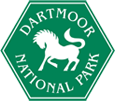Living Dartmoor - National and Regional Level
The value of Dartmoor in England’s Biodiversity
Dartmoor constitutes both the largest upland and area of semi-natural vegetation in southern England, and forms the most extensive granite landscape in the country. The combination of these features, along with the effects of a climate dominated by Atlantic influences has produced a unique mix of characteristic habitats and species. This includes internationally important vegetation communities such as blanket bogs (8,500 ha, 3.5% of England resource), upland heaths (7,300 ha, 3% of England resource), upland oakwoods (2,700 ha, c13% of England resource), and of at least national importance for rhos pastures (1,200 ha, 14% of England resource), lowland pastures (450 ha, 2.2%, of England resource) and valley mires (figure unknown for either Dartmoor or England). Additionally, the caves and mines of the Buckfastleigh area represent another internationally important habitat type. In turn these habitats hold internationally important wildlife including endemics such as Vigur’s eyebright, Heckford’s pygmy moth and a cave dwelling shrimp, plus the globally threatened Southern damselfly and Marsh fritillary butterfly. There are an additional number of species for which Dartmoor holds most if not all the UK population, such as Bog hoverfly, Blue ground beetle, Deptford pink and Flax-leaved St. John’s wort.
The state of Dartmoor's key wildlife 2011 (PDF).
Wider Benefits of Healthy Connected Habitats
The wildlife and landscape of Dartmoor has inspired and delighted generations of both locals and visitors to the area and there is clearly a duty to recognise the intrinsic value of wildlife and pass on the natural riches we have inherited to future generations.
Dartmoor is the principle source for water to much of Devon, with many of the county’s rivers emanating from the high moors and eight reservoirs supplying most of the population. Dartmoor’s deep peat is a store for 10 megatonnes of carbon – the equivalent of one year of CO2 output from the industry in the UK. Areas of deep peat in good condition continue to sequester more, helping to mitigate against future changes in climate, whilst eroding areas continue to lose this precious resource.
The beauty of the Dartmoor landscape draws millions of people to visit the National Park every year for a wide range of activities and there is a knock on benefit for a wide range of local businesses, including food and drink producers, accommodation providers and activity centres.
Developing Habitat Links
The value of large, interlinked wildlife habitats has been recognised for many years, but the pressures of a relatively dense population in a small country have meant this has been difficult to achieve.
On Dartmoor, we are fortunate to have a large central block of semi-natural moorland and grassland. Maintaining or improving the quality of these habitats and developing the natural networks which emanate from them, should be the focus of site management. This priority would apply both within the National Park and beyond to the surrounding parts of Devon. The rivers are the main habitat links due to their inherent value and the often steep-sided valleys they have created which hold a good proportion of other important wildlife habitats such as ancient woodland, rhos pastures and unimproved dry grasslands.
For more detail about how Living Dartmoor related to national and regional conservation priorities at the time of writing, download the complete original Living Dartmoor document (PDF).
